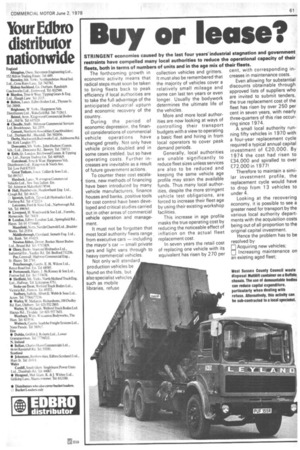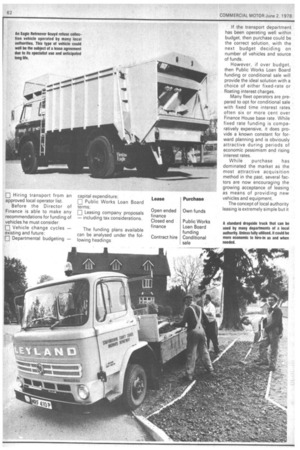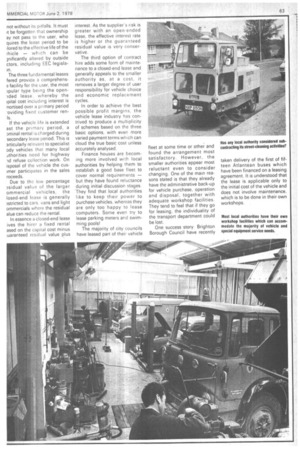Buy or lease?
Page 63

Page 64

Page 65

If you've noticed an error in this article please click here to report it so we can fix it.
STRINGENT economies caused by the last four years' industrial stagnation and government restraints have compelled many local authorities to reduce the operational capacity of their fleets, both in terms of numbers of units and in the age mix of their fleets.
The forthcoming growth in economic activity means that radical steps must soon be taken to bring fleets back to peak efficiency if local authorities are to take the full advantage of the anticipated industrial upturn and economic recovery of the country.
During the period of economic depression, the financil considerations of commercial vehicle operations have changed greatly. Not only have vehicle prices doubled and in some cases trebled. but so have operating costs. Further increases are inevitable as a result of future government actions.
To counter these cost escalations, new methods of financing have been introduced by many vehicle manufacturers, finance houses and banks, positive tools for cost control have been developed and critical studies carried out in other areas of commercial vehicle operation and management.
It must not be forgotten that most local authority fleets range from executive cars including the mayor's car small private cars and light vans through to heavy commercial vehicles.
Not only will standard production vehicles be found on the lists, but also specialist vehicles such as mobile libraries, refuse collection vehicles and graters. It must also be remembered that the majority of vehicles cover a relatively small mileage and some can last ten years or even longer. Usually the bodywork determines the ultimate life of the vehicles.
More and more local authorities are now looking at ways of controlling their transport budgets with a view to operating a basic fleet and hiring in from local operators to cover peak demand periods.
Generally, local authorities are unable significantly to reduce fleet sizes unless services are also to be reduced and keeping the same vehicle age profile may strain the available funds. Thus many local authorities, despite the more stringent vehicle test obligations, are forced to increase their fleet age by using their existing workshop facilities.
This increase in age profile masks the true operating cost by reducing the noticeable effect of inflation on the actual fleet replacement cost.
In seven years the retail cost of replacing one vehicle with its equivalent has risen by 270 per cent, with corresponding increases in maintenance costs.
Even allowing for substantial discounts obtainable through approved lists of suppliers who are invited to submit tenders, the true replacement cost of the fleet has risen by over 250 per cent in seven years, with nearly three-quarters of this rise occurring since 1974.
A small local authority running fifty vehicles in 1970 with a four-year replacement cycle required a typical annual capital investment of £20,000. By 1 974 the cost had risen to £34,000 and spiralled to over £72,000 in 1977!
Therefore to maintain a similar investment profile, the replacement cycle would have to drop from 13 vehicles to under 4.
Looking at the recovering economy, it is possible to see a greater need for transport by the various local authority departments with the acquisition costs being out of all proportion to the original capital investment.
Hence the problem has to be resolved by.
Acquiring new vehicles; Increasing maintenance on an existing aged fleet; LI Hiring transport from an approved local operator list.
Before the Director of Finance is able to make any recommendations for funding of vehicles he must consider: El Vehicle change cycles existing and future; El Departmental budgeting capital expenditure; Public Works Loan Board terms; E] Leasing company proposals — including tax considerations.
The funding plans available can be analysed under the following headings If the transport department has been operating well within budget, then purchase could be the correct solution, with the next budget deciding on number of vehicles and source of funds.
However, if over budget, then Public Works Loan Board funding or conditional sale will provide the ideal solution with a choice of either fixed-rate or floating interest charges.
Many fleet operators are prepared to opt for conditional sale . with fixed time interest rates often six or more cent over Finance House base rate. While fixed rate funding is comparatively expensive, it does provide a known constant for forward planning and is obviously attractive during periods of economic pessimism and rising interest rates.
While purchase has dominated the market as the most attractive acquisition method in the past, several factors are now encouraging the growing acceptance of leasing as means of providing new vehicles and equipment.
The concept of local authority leasing is extremely simple but it not without its pitfalls. It must it be forgotten that ownership ay not pass to the user, who quires the lease period to be 'bored to the effective life of the ihide — which can be jnificantly altered by outside ctors, including EEC legisla The three fundamental leases fered provide a comprehensa facility for the user, the most )pular type being the openided lease. whereby the ipital cost including interest is nortised over a primary period oviding fixed customer renIs.
If the vehicle life is extended ast the primary period, a Dminal rental is charged during secondary lease period. This is articularly relevant to specialist ody vehicles that many local Jthorities need for highway id refuse collection work. On isposal of the vehicle the cus>mer participates in the sales roceeds.
Due to the low percentage asidual value of the larger ommercial vehicles, the losed-end lease is generally .3stricted to cars. vans and light ommercials where the residual alue can reduce the rental.
In essence a closed-end lease ives the hirer a fixed rental ased on the capital cost minus luaranteed residual value plus
interest. As the supplier's risk is greater with an open-ended lease, the effective interest rate is higher or the guaranteed residual value is very conservative.
The third option of contract hire adds some form of maintenance to a closed-end lease and generally appeals to the smaller authority as, at a cost, it removes a larger degree of user responsibility for vehicle choice and economic replacement cycles.
In order to achieve the best possible profit margins, the vehicle lease industry has contrived to produce a multiplicity of schemes based on the three basic options, with even more varied payment terms which can cloud the true basic cost unless accurately analysed.
Finance houses are becoming more involved with local authorities by helping them to establish a good base fleet to cover normal requirements — but they have found reluctance during initial discussion stages. 'They find that local authorities like to keep their power to purchase vehicles, whereas they are only too happy to lease computers. Some even try to lease parking meters and swimming pools!
The majority of city councils have leased part of their vehicle fleet at some time or other and found the arrangement most satisfactory. However, the smaller authorities appear most reluctant even to consider changing. One of the main reasons stated is that they already have the administrative back-up for vehicle purchase, operation and disposal, together with adequate workshop facilities. They tend to feel that if they go for leasing, the individuality of the transport department could be lost.
One success story Brighton Borough Council have recently
taken delivery of the first of fifteen Atlantean buses which have been financed on a leasing agreement. It is understood that the lease is applicable only to the initial cost of the vehicle and does not involve maintenance, which is to be done in their own workshops.








































































































































